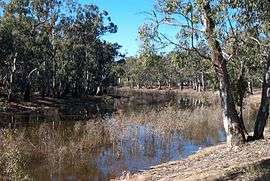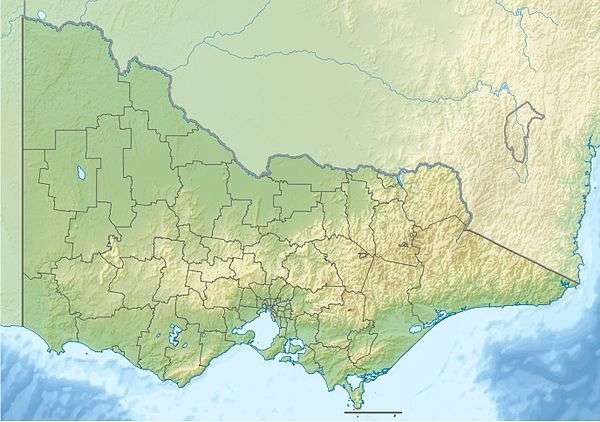Barmah National Park
| Barmah National Park Victoria | |
|---|---|
|
IUCN category II (national park) | |
 River Red Gums along the Murray River, adjacent to the national park | |
 Barmah National Park | |
| Nearest town or city | Barmah |
| Coordinates | 35°52′00″S 145°07′05″E / 35.86667°S 145.11806°ECoordinates: 35°52′00″S 145°07′05″E / 35.86667°S 145.11806°E |
| Established | 2010 |
| Area | 285.21 km2 (110.1 sq mi)[1] |
| Managing authorities | Parks Victoria |
| Website | Barmah National Park |
| See also | Protected areas of Victoria |
The Barmah National Park is a national park located in the Hume region of the Australian state of Victoria.[2] The 28,500-hectare (70,000-acre) park is located adjacent to the Murray River near the town of Barmah, approximately 220 kilometres (140 mi) north of Melbourne. The park consists of River Red Gum (Eucalyptus camaldulensis) forest and wetlands. The area is subject to sporadic flooding from natural and irrigation water flows.
History
Barmah National Park was originally utilised by Indigenous Australians to find food, shelter and materials. Following the settlement of Europeans into the area, the Barmah National Park became an important fishing and logging area, with surrounding land cleared for agriculture and grazing. Rabbits, foxes, sheep, cattle and horses were introduced into the area.[3][4] To this day, the Barmah National Park is home to small herds of horses, known as Barmah horses,[5] a type of brumby. However plans exist to remove the horses from the park. Hardwood timber was harvested from the Barmah region from around 1870[4] and logging was an important industry in the region.
The park was one of four established by the Victorian Government in 2010 to protect remnant River Red Gum forest.[6] The other parks created were the Gunbower National Park, Lower Goulburn National Park and the Warby-Ovens National Park.
In July 2010, the Government of New South Wales declared the Millewa Forest, on the northern banks of the Murray River, as a national park. The 41,601-hectare (102,800-acre) forest was renamed as the Murray Valley National Park, making the combined reserves a 70,000-hectare (170,000-acre) cross–border national park, managed by both governments and the Traditional Owners.[7][8] The combined parks are the largest continuous red gum forest in the world.[9][10][11]
The Barmah National Park is a popular camping, fishing, bird watching and recreation destination.[8]
Climate
The Barmah National Park is known as a temperate semi-arid region, with low rainfall and high evaporation.[12] Average temperature maximums for the year are around 30 °C (86 °F) in January and February, with average minimum temperatures down to 4 °C (39 °F) in July. Average rainfall for the year is 400 millimetres (16 in), with the most rain falling in winter with an average monthly rainfall of 40 millimetres (1.6 in).[13]
Ecology
The Barmah National Park is a River Red Gum forest, consisting of an upper storey of red gums, no shrub layer or middle storey, and a ground storey of native grasses, sedges and rushes.[3][4][9] The edges of the forest merge into a eucalypt-box woodland.
The park is a large flood plain and wetland area, with flooding of the Murray River occurring sporadically, both naturally and due to flow regulation of the river.[14] The main fauna type found within the park are waterbirds. The area is a rich breeding, nesting and foraging area for over 200 bird species. It is also one of the largest breeding grounds of water birds in Victoria.[8] Reptiles and amphibians are also found within the river red gum forest, as well as many native fish species in the river, including the Murray Cod. The main native mammals found include the grey kangaroo, koala, emu and possum species.[8] Introduced animals such as rabbits, foxes and horses can also be seen throughout the park.
Environmental threats
Following European settlement of the area, land was extensively cleared to allow for farming and agriculture. Sheep and cattle grazing was a common sight around the Barmah region from the mid to late 1800s.[4][9][15] The periodic burning previously undertaken by Indigenous Australians was also halted.[3][9] Logging of the River Red Gum forests was an important part of the late 1800s and early 1900s.[4][9]
The construction of dams upstream from the Barmah National Park, from the 1920s onwards, have had a vast impact on the water flowing in the Murray River and instances of flooding.[16] The Hume Dam was operational from 1936, the Yarrawonga Weir in 1939, and the Dartmouth Dam from 1979.[3][9][12][16]
Since clearing for agriculture, and the subsequent dam construction took place, the Murray River has undergone some form of flow regulation.[16][17] The Barmah National Park and surrounding River Red Gum forests should naturally flood in spring and winter, due to the water catchment of the Murray River. However, due to flow regulation, the floods now occur in summer and autumn and are less frequent and of shorter duration than previously.[10][18]
A significant decrease in breeding and occurrence of waterbirds, particular woodland bird species and species of migratory birds has been reported in the Barmah National Park.[17] This decrease has been attributed to the changes to the flood regimes occurring in the area.[17]
A number of marsupial species are also no longer found within the park, including the rufous bettong, bridled nailtail wallaby, western barred bandicoot and lesser stick-nest rat.[3] Their absence has been attributed to the introduction of rabbits and foxes.[3]
The future impact of climate change on River Red Gum forests is unknown.
Management
The Barmah Forest was declared as a national park by the Victorian Government in 2010 under the National Parks Act, 1975 (VIC). The park is managed as part of a collaboration between Parks Victoria and the Traditional Owners of the area, including the Yorta Yorta people.[8]
The Barmah National Park is an internationally recognised wetland, listed under the Ramsar Convention,[8][10][12][19] and a number of bird species that utilise the Barmah National Park are part of the Japan-Australia Migratory Bird Agreement (JAMBA) and the China-Australia Migratory Bird Agreement (CAMBA).[10][12]
Flow regulation of the Murray River to benefit the surrounding agricultural land, has been undertaken for many years. However, more recently the importance of environmental flows is becoming increasingly acknowledged.[15]
Scientific study has shown that River Red Gums rely on specific levels and durations of floods in order to survive and regenerate, similarly waterbird species also have very specific flood-related conditions in order to successfully breed and fledge chicks.[12][20] Flow regimes are also very important for native fish species populations.[19] Therefore, the alterations to the management of River Red Gum forests and regulation of water flows within the Murray River will be a very important area of study into the future.[15]
The issue of ecological burns also needs to be assessed very carefully for future management of the Barmah National Park.
See also
References
- ↑ "Barmah National Park: Visitor Guide" (PDF). Parks Victoria (PDF). Government of Victoria. June 2014. Retrieved 20 August 2014.
- ↑ "Barmah National Park". Parks Victoria. Government of Victoria. Retrieved 15 April 2013.
- 1 2 3 4 5 6 Di Stefano, Julian (2002). "River red gum (Eucalyptus camaldulensis): a review of ecosystem processes, seedling regeneration and silvicultural practice". Australian Forestry. 65 (1): 14–22. doi:10.1080/00049158.2002.10674848.
- 1 2 3 4 5 Kenyon, C; Rutherford (1999). "Preliminary evidence for pollen as an indicator of recent floodplain accumulation rates and vegetation changes: the Barmah-Millewa Forest, SE Australia". Environmental Management. 55: 359–367. doi:10.1007/s002679900239.
- ↑ "Barmah horse management program". Parks Victoria. Retrieved 21 April 2013.
- ↑ "Parks and Crown Land Legislation Amendment (River Red Gums) Bill 2009". 2009. Retrieved 2012-01-30.
- ↑ "River Red Gum forests and wetlands". Environment Victoria. Retrieved 21 April 2013.
- 1 2 3 4 5 6 "Barmah National Park Visitor Guide" (PDF). Parks Victoria. Retrieved 11 April 2013.
- 1 2 3 4 5 6 Bren, L. J. (1988). "Effects of river regulation on flooding of a riparian red gum forest on the River Murray, Australia". Regulated Rivers: Research & Management. 2: 65–77. doi:10.1002/rrr.3450020202.
- 1 2 3 4 Chong, J; Ladson (2003). "Analysis and management of unseasonal flooding in the Barmah-Millewa Forest, Australia". River Research and Applications. 19: 161–180. doi:10.1002/rra.705.
- ↑ "Murray Valley National Park". NSW National Parks & Wildlife Service. Government of New South Wales. Retrieved 9 August 2014.
- 1 2 3 4 5 Leslie, D. J. (2001). "Effect of river management on colonially-nesting waterbirds in the Barmah-Millewa Forest, south-eastern Australia". Regulated Rivers: Research & Management. 17: 17–31. doi:10.1002/1099-1646(200101/02)17:1<21::aid-rrr589>3.0.co;2-v.
- ↑ "Echuca aerodrome". Bureau of Meteorology. Retrieved 21 April 2013.
- ↑ Argent, R. M.; McMahon T. A; Bowler J. M; Finlayson B. L. (2004). "The dendroecological Potential of Eucalyptus camaldulensis Dehnhardt (River Red Gum) from the Barmah Forest, Victoria, Australia". Australian Geographical Studies. 42 (1): 89–102. doi:10.1111/j.1467-8470.2004.00245.x.
- 1 2 3 Bennett, J (2008). "Defining and managing environmental flows: inputs from society". Economic Papers. 27 (2): 167–183. doi:10.1111/j.1759-3441.2008.tb01035.x.
- 1 2 3 Thoms, M. C. (1995). "The impact of catchment development on a semiarid wetland complex: the Barmah Forest, Australia". IAHS Publications-Series of Proceedings and Reports-Intern Assoc Hydrological Sciences. 230: 121–130.
- 1 2 3 McGinness, H. A.; Arthur A. D; Reid, J. R. W (2010). "Woodland bird declines in the Murray-Darling Basin: are there links with floodplain change?". The Rangeland Journal. 32: 315–327.
- ↑ Glazebrook, H. S.; Robertson A. I. (1999). "The effect of flooding and flood timing on leaf litter breakdown rates and nutrient dynamics in a river red gum (Eucalyptus camaldulensis) forest". Australian Journal of Ecology. 24: 625–635. doi:10.1046/j.1442-9993.1999.00992.x.
- 1 2 King, A. J.; Ward K. A; O’Connor P; Green D; Tonkin Z; Mahoney J. (2010). "Adaptive management of an environmental watering event to enhance native fish spawning and recruitment". Freshwater Biology. 55: 17–31. doi:10.1111/j.1365-2427.2009.02178.x.
- ↑ Briggs, S. V.; Thornton S. A; Lawler W. G (1997). "Relationships between hydrological control of River Red Gum wetlands and waterbird breeding". Emu. 97: 31–42. doi:10.1071/mu97003.